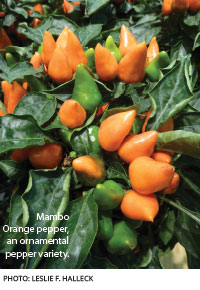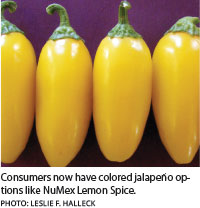 As consumers’ taste buds heat up, so has the demand for hot pepper varieties. The hotter the better, it seems. Americans are abandoning the mild or bland flavors of traditional comfort foods for those of more exotic and adventurous cuisines. Immigrants to the U.S. have brought with them the spicy flavors of their native fare; younger consumers are embracing them as part of their mainstream food choices. While spicy foods and hot peppers were once relegated to niche restaurants or specialty markets, you can now find the spiciest of flavors offered up at national fast food chains and standard grocery store shelves. It doesn’t seem like the need for heat is going to slow down anytime soon.
As consumers’ taste buds heat up, so has the demand for hot pepper varieties. The hotter the better, it seems. Americans are abandoning the mild or bland flavors of traditional comfort foods for those of more exotic and adventurous cuisines. Immigrants to the U.S. have brought with them the spicy flavors of their native fare; younger consumers are embracing them as part of their mainstream food choices. While spicy foods and hot peppers were once relegated to niche restaurants or specialty markets, you can now find the spiciest of flavors offered up at national fast food chains and standard grocery store shelves. It doesn’t seem like the need for heat is going to slow down anytime soon.
History of heat
Tasting capsaicin, the compound that creates the hot sensation in peppers, isn’t exactly a pleasant experience at first; it’s a defense mechanism used by the plants to prevent their seed from being consumed and destroyed by predators or succumbing to fungal diseases. It’s not meant to be a desirable “flavor.” So it’s likely that it took a long time for people to learn to enjoy eating hot peppers. Humans and hot peppers probably first crossed paths about 12,000 years ago in what we now call Mexico. As we learned that spices were the key to making food more flavorful, hot pepper cultivation was developed. After Christopher Columbus brought hot peppers to Spain, they subsequently influenced cuisine across the globe; especially in Asia. Now it seems humans are hooked on the burn.
Not hot enough
 Standard jalapeños don’t cut it these days for seekers of spicy foods. Consumers are building a tolerance for a wider range of heat and are looking for hotter and hotter pepper varieties. Breeders are working double-time to develop new varieties that push the boundaries of human taste buds and tolerance.
Standard jalapeños don’t cut it these days for seekers of spicy foods. Consumers are building a tolerance for a wider range of heat and are looking for hotter and hotter pepper varieties. Breeders are working double-time to develop new varieties that push the boundaries of human taste buds and tolerance.
A couple years ago, Guinness awarded the title of “World’s Hottest Pepper’ to the ‘Carolina Reaper,’ which scored 1.6 million units on the Scoville Scale, which measures the spiciness of peppers. By comparison, jalapeño peppers rate between 1,000 and 4,000 on the scale. The same breeder who created the ‘Carolina Reaper,’ Ed Currie, has now created a new taste bud burner called ‘HP56.’ It’s reported to register double the heat of his previous creation.
Pepper preparation
According to the Agricultural Marketing Research Center and Iowa State University, American consumption of both sweet and hot peppers has increased significantly over the past 10 years. We’re eating more hot peppers as a part of spicy food cuisine and more sweet bell peppers as healthy snacks.
How Americans prepare peppers is also changing. Stuffed peppers are becoming more popular as a prepared food item; some pepper varieties have been developed specifically to be sold pre-stuffed. Hazera Seed developed their ‘Josh’ pepper variety specifically for this purpose.
Flavor counts
In addition to seeking out “heat” from chile peppers, consumers and chefs are also looking for different flavors from their peppers. According to Paul Bosland, Regents professor of Horticulture at New Mexico State University and the Chile Pepper Institute Director, tastes are becoming more sophisticated. “We are seeing an increased interest in “flavor” of chile peppers. Chile peppers are very diverse in their flavor profiles. In the U.S., people are getting educated about chile pepper flavor, and are learning that not all chile peppers taste the same.
 In response to this changing demand for flavor, breeders aren’t just focusing on heat anymore. “For example,” Bosland says, “the Chile Pepper Institute released ‘NuMex Heritage 6-4’ and ‘NuMex Big Jim’ with 600 percent and 500 percent more flavor, respectively, than the current commercial green chile being grown.”
In response to this changing demand for flavor, breeders aren’t just focusing on heat anymore. “For example,” Bosland says, “the Chile Pepper Institute released ‘NuMex Heritage 6-4’ and ‘NuMex Big Jim’ with 600 percent and 500 percent more flavor, respectively, than the current commercial green chile being grown.”
More demand for diverse flavors means a growing demand for a wider selection of peppers; that’s good news for growers.
Color me hot
While not surprising, new color choices are another fun trend gaining steam in the pepper breeding world. We all know consumers respond strongly to color, so why shouldn’t the same apply to vegetable choices? Breeders have responded and gone are the days of “just green” jalapenos. The Chile Pepper Institute is delivering on this trend. “As with other vegetables, the consumer likes the ability to have a selection in colors,” says Bosland. “Just this year, The Chile Pepper Institute released three colorful jalapenos, NuMex Orange Spice, NuMex Lemon Spice and NuMex Pumpkin Spice.”
Pumpkin Spice? With a name like that, this hot pepper addict won’t be able to resist.
Keep it saucy
Spicy sauces are also topping the list of on-trend food items in 2015. If you had to pick one condiment that captivated America’s palette, it would be sriracha sauce. Sriracha, a hot sauce made from chili pepper paste, vinegar and seasonings, can now be seen taking the place of more traditional hot sauces at the breakfast, lunch and dinner table. Heinz has even developed a new sriracha flavored ketchup. That’s about as mainstream as it gets. Selling peppers directly to food producers of spicy sauces has become big business for some pepper growers.
Infusions have been on trend for the last few years as well, especially infused spirits. Herbs have traditionally provided the flavors of choice for such infusions, but lately, hot peppers are taking their place. Recipes for chili infused vodka and honey are popping up all over the Internet. The prepared foods market has also picked up on this trend and hot pepper infused foods are beginning to show up on market shelves.
Small and sweet
While hot peppers are definitely garnering a big chunk of consumer’s focus at the moment, snack-sized sweet bell peppers are also on trend. The National Garden Bureau is marketing the sweet pepper as its Vegetable of the Year for 2015. As Americans cook less, they’re also looking for ways to cut down on food preparation time. Seedless mini-bell peppers that are pre-packaged as snack and party food are gaining in popularity.
Pepper production
Despite our growing appetite for peppers of all kinds, the U.S. produces only a tiny percentage of the global pepper market. Imports make up a majority of U.S. pepper sales. Most domestically grown peppers are still grown in-field with drip irrigation, while most imports tend to be greenhouse-grown. Trade agreements and labor costs have put most of the pressure on the U.S. pepper growers.
However, specialty products are definitely trending right now in the greenhouse production industry. While the numbers of field grown peppers grown in New Mexico (the number one chile producing state) have been steadily declining over the last several years, states like Florida have been increasing their numbers of greenhouse-grown peppers. Growers using high-tunnel or controlled greenhouse facilities can potentially produce specialty hot peppers year-round. Many growers are also successfully shifting production over to hydroponic systems.
Because pepper production is well-suited to small-scale farms or seasonal production, there are good opportunities to be had for niche growers. Small farmers that supply market gardens, local restaurants and small local food producers can provide in-demand specialty chile peppers. Ornamental growers looking to diversify their offerings, and take advantage of the growth in edibles, should consider adding hot peppers to their offerings.

Explore the August 2015 Issue
Check out more from this issue and find you next story to read.





